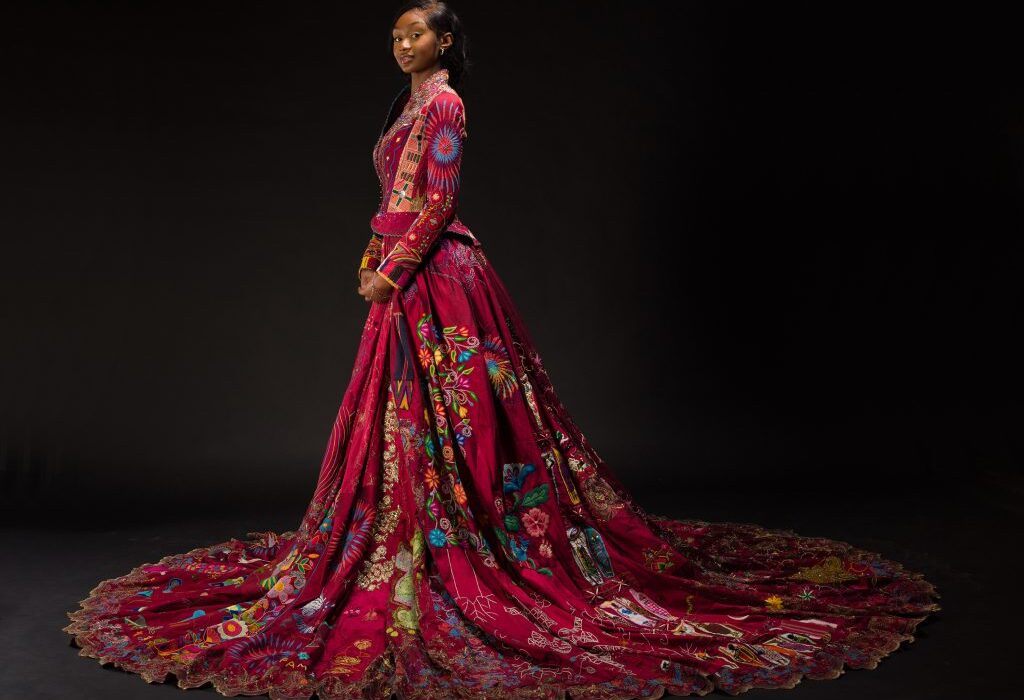The Red Dress exhibit, showcasing the talent of hundreds of embroiderers, is on display at Pittsburgh’s Frick Art Museum through Jan. 28.
From now through Jan. 28, the public can view a vibrant collaborative embroidery project at Pittsburgh’s Frick Art Museum. Known simply as The Red Dress, the garment showcases the talent of hundreds of embroiderers.
Dawn Brean, chief curator and director of collections at The Frick, said that the artist’s initial conception was a feminist performance to begin a dialogue on cultural identity and embroidery.
“Artist Kirstie Macleod initially exhibited the dress as an art installation by sitting in a clear cube while embroidering it, but eventually she stopped wearing the dress,” said Brean.
What followed was an intense interest in the strength and spirit of these talented artisans, resulting in the dress being showcased around the world. Brean estimates that during the first day of the exhibit, about 500 visitors saw the dress. Speaking for the artist, Brean explains why the color red was chosen.
“Kirstie was drawn to the red color to represent power, the heart and emotion,” said Brean.
Macleod’s work has inspired a community project as well: The Pittsburgh Calico Dress.
“It’s joyful, exuberant and a celebration of diversity,” said Brean, adding that materials include lace, cross stitching, crochet and embroidery. “It represents Pittsburgh, and the Steelers also make an appearance,” she said, with a chuckle.
An Artist’s Journey
Macleod, who started The Red Dress project in 2009, describes her work as that of exploring issues of identity and the passage of time through textiles, photography and installation. The Glastonbury, England-based artist who lived in many different countries during her childhood, became very interested in color, texture and language.
“My father worked in energy, and an Indian teacher in Nigeria taught me to embroider,” Macleod said.
The Red Dress took 14 years to complete and has been worked on by 367 women and girls, 11 men and boys and two non-binary artists from 51 different countries. The striking, colorful and elegant garment has become a medium of expression for many of those across the world living in vulnerable circumstances due to war, poverty, or refugee status.
Macleod explains how the frock has helped those who have worked on it over the years.
“We have commissioned embroiderers who get a portion of money based on the number of people who visit the exhibit,” she said, adding that she believes that she’ll be working with the dress for the rest of her life. “I do lots of outreach engagements with charities and the vulnerable,” said Macleod.
Embroiderers include female refugees from Palestine, Syria and Ukraine, women seeking asylum in the UK from Iran, Iraq, China, Nigeria and Namibia and survivors of war in Kosovo, Bosnia and Herzegovina, to name a few. Macleod said one of her most memorable moments was when she was invited to bring the dress to the parliament in Kosovo.
“MP Saranda Bogujevci wore the Red Dress inside Kosovo Parliament,” she said.
Bogujevci survived 16 bullets and lost eight members of her immediate family, including her mother and two brothers in a massacre during the ethnic cleansing of Albanians in 1998-1999. Bogujevci later testified before a Serbian court about atrocities and several convictions followed. Fatima and Feride Halili are from the region and stitched the ‘Birds of Peace’ panel for the dress in 2019, which symbolizes the journey that refugees took by fleeing to the mountains to avoid the war that destroyed so much of their homeland.
According to Macleod, although many of the embroiderers were professionals, there were also first-time embroiderers engaged in the project. “We really wanted to offer an opportunity for many people to tell their own stories through thread,” Macleod said, adding that visitors will have the opportunity to learn more about the participants through story panels that run with the exhibit. As for the future, Macleod said that there will be additional ways to get the word out through an upcoming coffee table book and a film that is in the works.
Meanwhile, Brean is hoping that more visitors will come out to behold the beauty of the dress. “We are always looking for exhibitions that tell a story about this extremely powerful, symbolic artwork representing community and understanding that brings to light a lot of issues in society which affect individuals in the world today,” she said.

